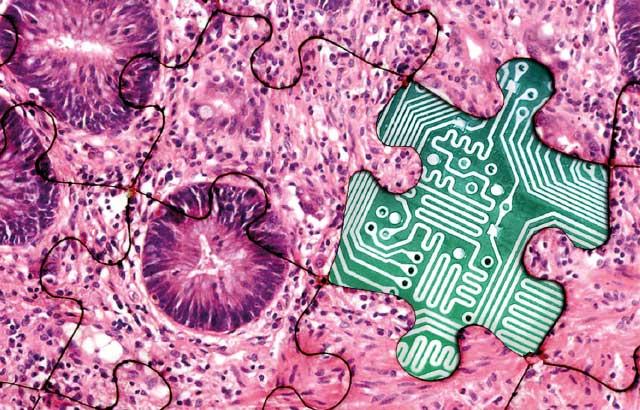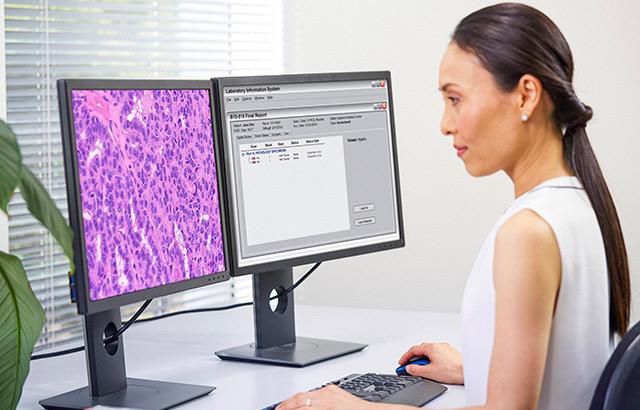
Creating Digital Ready Slides - A Practical Guide

The adoption of digital pathology is a multifaceted project involving many stakeholders across the pathology department. The impact on the laboratory is not isolated to simply installing a scanner but rather affects the whole workflow to generate optimized Digital Ready Slides. Standardization of histological slide preparation requires focusing on optimizing individual workflow steps and a holistic overview of the complete process from sample acquisition right through to diagnosis. Knowing this in advance and taking appropriate steps to support effectively change management can promote engagement and pave a path to success.
Key Learning Objectives:
- Define the critical attributes of Digital Ready Slides
- Demonstrate the impact of tissue preparation steps on scan quality
- Provide practical guidance to creating Digital Ready Slides and additional considerations at each laboratory step
About the presenter

Dr. Colgan has over a decade of experience in the digital pathology sector and is focused on how this new and disruptive technology can be leveraged to provide real benefits in both the healthcare and research domains. Prior to working with Leica Biosystems, she came from a research background with a BSc in Biotechnology and a PhD in Vascular Biology from Dublin City University, Ireland.
References
- Fraggetta, Filippo & Garozzo, Salvatore & Zannoni, GianFranco & Pantanowitz, Liron & Rossi, EstherDiana. (2017). Routine Digital Pathology Workflow: The Catania Experience. Journal of Pathology Informatics. 8. 51. 10.4103/jpi.jpi_58_17.
- Williams, Bethany & Hanby, Andrew & Millican‐Slater, Rebecca & Nijhawan, Anju & Verghese, Eldo & Treanor, Darren. (2017). Digital Pathology for the Primary Diagnosis of Breast Histopathological Specimens: An Innovative Validation and Concordance Study. Histopathology. 72. 10.1111/his.13403.
- Hanna, Matthew & Reuter, Victor & Ardon, Orly & Kim, David & Sirintrapun, Sahussapont & Schüffler, Peter & Busam, Klaus & Sauter, Jennifer & Brogi, Edi & Tan, Lee & Xu, Bin & Bale, Tejus & Agaram, Narasimhan & Tang, Laura & Ellenson, Lora & Philip, John & Corsale, Lorraine & Stamelos, Evangelos & Friedlander, Maria & Hameed, Meera. (2020). Validation of a digital pathology system including remote review during the COVID-19 pandemic. Modern Pathology. 33. 10.1038/s41379-020-0601-5.
- College of American Pathologists, “COVID-19 – Remote Sign-Out Guidance” (2020). Available at: capatholo.gy/3ghf4Wu.
- Centers for Medicare & Medicaid Services, “Clinical Laboratory Improvement Amendments (CLIA) Laboratory Guidance During COVID-19 Public Health Emergency” (2020). Available at: go.cms.gov/2LGD2wh.
- Royal College of Pathologists, “Guidance for remote reporting of digitalpathology slides during periods of exceptional service pressure” (2020). Available at: https://www.rcpath.org/profession/digital-pathology.html
- McCarthy, J. & Minsky, M.L. & Rochester, N. & Shannon, C.E.. (1955).proposal for the Dartmouth summer research project on artificial intelligence. Artificial Intelligence: Critical Concepts. 2. 44-53.
- Kanavati, Fahdi & Toyokawa, Gouji & Momosaki, Seiya & Rambeau, Michael & Kozuma, Yuka & Shoji, Fumihiro & Yamazaki, Koji & Takeo, Sadanori & Iizuka, Osamu & Tsuneki, Masayuki. (2020). Weakly-supervised learning for lung carcinoma classification using deep learning. Scientific Reports. 10.10.1038/s41598-020-66333-x.
- Iizuka, Osamu & Kanavati, Fahdi & Kato, Kei & Rambeau, Michael & Arihiro, Koji & Tsuneki, Masayuki. (2020). Deep Learning Models for Histopathological Classification of Gastric and Colonic Epithelial Tumours. Scientific Reports. 10. 10.1038/s41598-020-58467-9.
- McCampbell, Adrienne & Raghunathan, Varun & Tom-Moy, May & Workman, Richard & Haven, Rick & Ben-Dor, Amir & Rasmussen, Ole & Jacobsen, Lars & Lindberg, Martin & Yamada, N. & Schembri, Carol. (2017). Tissue Thickness Effects on Immunohistochemical Staining Intensity of Markers of Cancer. Applied Immunohistochemistry & Molecular Morphology. 27. 1. 10.1097/PAI.0000000000000593.
- Masuda, Shinobu & Suzuki, Ryohei & Kitano, Yuriko & Nishimaki, Haruna & Kobayashi, Hiroko & Nakanishi, Yoko & Yokoi, Hideo. (2020). Tissue Thickness Interferes With the Estimation of the Immunohistochemical Intensity: Introduction of a Control System for Managing Tissue Thickness. Applied Immunohistochemistry & Molecular Morphology. Publish Ahead of Print. 1. 10.1097/PAI.0000000000000859.
- Arif, Ahmed & Stuerzlinger, Wolfgang. (2009). Analysis of text entry performance metrics. TIC-STH’09: 2009 IEEE Toronto International Conference - Science and Technology for Humanity. 100 - 105. 10.1109/TICSTH.2009.5444533.
Related Content
Leica Biosystems Knowledge Pathway content is subject to the Leica Biosystems website terms of use, available at: Legal Notice. The content, including webinars, training presentations and related materials is intended to provide general information regarding particular subjects of interest to health care professionals and is not intended to be, and should not be construed as, medical, regulatory or legal advice. The views and opinions expressed in any third-party content reflect the personal views and opinions of the speaker(s)/author(s) and do not necessarily represent or reflect the views or opinions of Leica Biosystems, its employees or agents. Any links contained in the content which provides access to third party resources or content is provided for convenience only.
For the use of any product, the applicable product documentation, including information guides, inserts and operation manuals should be consulted.
Copyright © 2025 Leica Biosystems division of Leica Microsystems, Inc. and its Leica Biosystems affiliates. All rights reserved. LEICA and the Leica Logo are registered trademarks of Leica Microsystems IR GmbH.



